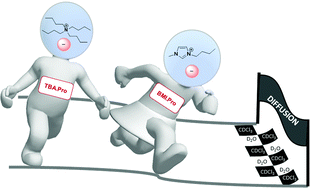Dealing with supramolecular structure for ionic liquids: a DOSY NMR approach†
Abstract
Diffusion-ordered spectroscopy (DOSY) is arguably a powerful method for the NMR analysis of ionic liquids, since the self-diffusion coefficients for cations and anions can be measured straightforwardly. In this work, the dynamic-structural behaviour of imidazolium ionic liquids containing different anions has been investigated by experimental measurements of direct 1H diffusion coefficients in chloroform and water solutions. The influence of ion structure has been tested by using six IL salts formed by the association of different cations (1-n-butyl-3-methylimidazolium, 1,2,3-trimethylimidazolium and tetra-n-butylammonium) with different anion structures (prolinate, acetate and o-trifluoromehtylobenzoate). The influence of IL concentration (from 0.01 to 0.5 mol L−1) was also evaluated for BMI·Pro. The contact ion pairs (or aggregates) are maintained in both chloroform and water within the range of concentrations investigated. In the particular case of 1,2,3-trimethylimidazolium imidazolate (TMI·Im) containing confined water in DMSO the maintenance of the contact ion pairs depends on the water content which may even disrupt the IL supramolecular structure.

- This article is part of the themed collection: Celebrating Latin American Talent in Chemistry


 Please wait while we load your content...
Please wait while we load your content...